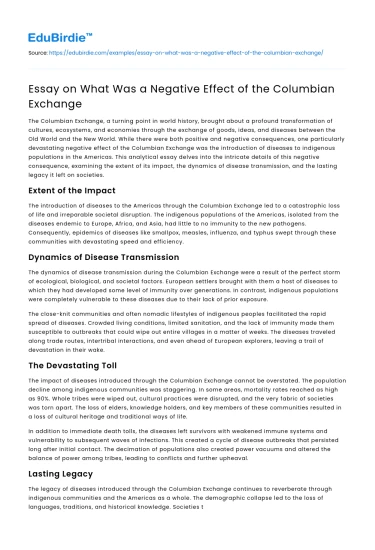The Columbian Exchange, a turning point in world history, brought about a profound transformation of cultures, ecosystems, and economies through the exchange of goods, ideas, and diseases between the Old World and the New World. While there were both positive and negative consequences, one particularly devastating negative effect of the Columbian Exchange was the introduction of diseases to indigenous populations in the Americas. This analytical essay delves into the intricate details of this negative consequence, examining the extent of its impact, the dynamics of disease transmission, and the lasting legacy it left on societies.
Extent of the Impact
The introduction of diseases to the Americas through the Columbian Exchange led to a catastrophic loss of life and irreparable societal disruption. The indigenous populations of the Americas, isolated from the diseases endemic to Europe, Africa, and Asia, had little to no immunity to the new pathogens. Consequently, epidemics of diseases like smallpox, measles, influenza, and typhus swept through these communities with devastating speed and efficiency.
Save your time!
We can take care of your essay
- Proper editing and formatting
- Free revision, title page, and bibliography
- Flexible prices and money-back guarantee
Dynamics of Disease Transmission
The dynamics of disease transmission during the Columbian Exchange were a result of the perfect storm of ecological, biological, and societal factors. European settlers brought with them a host of diseases to which they had developed some level of immunity over generations. In contrast, indigenous populations were completely vulnerable to these diseases due to their lack of prior exposure.
The close-knit communities and often nomadic lifestyles of indigenous peoples facilitated the rapid spread of diseases. Crowded living conditions, limited sanitation, and the lack of immunity made them susceptible to outbreaks that could wipe out entire villages in a matter of weeks. The diseases traveled along trade routes, intertribal interactions, and even ahead of European explorers, leaving a trail of devastation in their wake.
The Devastating Toll
The impact of diseases introduced through the Columbian Exchange cannot be overstated. The population decline among indigenous communities was staggering. In some areas, mortality rates reached as high as 90%. Whole tribes were wiped out, cultural practices were disrupted, and the very fabric of societies was torn apart. The loss of elders, knowledge holders, and key members of these communities resulted in a loss of cultural heritage and traditional ways of life.
In addition to immediate death tolls, the diseases left survivors with weakened immune systems and vulnerability to subsequent waves of infections. This created a cycle of disease outbreaks that persisted long after initial contact. The decimation of populations also created power vacuums and altered the balance of power among tribes, leading to conflicts and further upheaval.
Lasting Legacy
The legacy of diseases introduced through the Columbian Exchange continues to reverberate through indigenous communities and the Americas as a whole. The demographic collapse led to the loss of languages, traditions, and historical knowledge. Societies that had been flourishing for centuries were forever altered, and the trauma of the epidemics remains a part of collective memory.
Furthermore, the uneven impacts of diseases on different regions played a significant role in shaping the course of history. The collapse of indigenous societies created opportunities for European colonization and settlement. The weakened indigenous populations were often exploited as a source of labor, contributing to the entrenchment of colonization and the erosion of native sovereignty.
Conclusion
In conclusion, the introduction of diseases to indigenous populations in the Americas through the Columbian Exchange stands as a tragic and deeply negative consequence of this historic event. The diseases, facilitated by the lack of immunity, cultural practices, and ecological factors, led to catastrophic mortality rates, disrupted societies, and left a lasting legacy of trauma and loss.
The examination of this negative effect underscores the intricate interplay between human societies and the ecosystems they inhabit. The Columbian Exchange serves as a reminder that the consequences of historical events are multifaceted and can result in both intended and unintended outcomes. Understanding the impact of diseases in the wake of the Columbian Exchange compels us to reflect on the complex dynamics of disease transmission, the resilience of indigenous communities, and the importance of acknowledging historical injustices as we strive for a more equitable and just future.






 Stuck on your essay?
Stuck on your essay?

